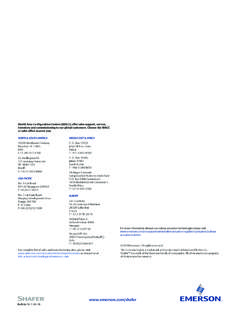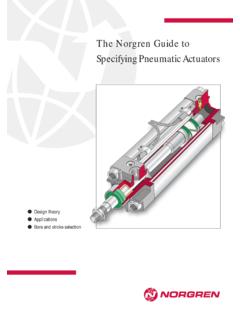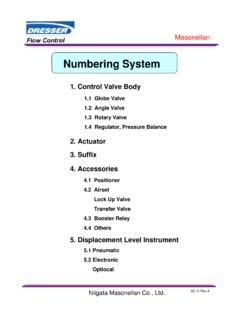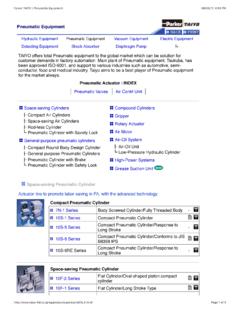Transcription of E-training - K Controls Ltd
1 E-training Welcome to theK Controls E-training course designed to deliver useful Pneumatic Valve Actuation application information in small instalments. To unsubscribe or toregister a colleague to receive these documentsClick hereSolenoid control of pneumatic actuatorsPneumatic actuators need solenoid valves to control the supply of air. This they do by diverting or stopping the supply of air to one side of the piston or vane while allowing for air to be exhausted from the other. A direct acting solenoid is not often used on its own as the flow rate is usually insufficient, causing the actuator to operate too slowly. To overcome this problem direct acting solenoids are used in combination with pilot valves that contain either spools or poppets. These allow air to enter and leave the actuator more quickly. Solenoids can either be fitted remotely, usually grouped together in cabinets, or directly to the actuator.
2 Remotely sited solenoids can be protected from a harsh or hazardous plant environment but the air has to be exhausted via the interconnecting pneumatic piping. This can cause a time lag between solenoid and actuator operation. In addition identifying a faulty solenoid via an actuator failure can take longer unless they are clearly identified in the cabinet. What is a solenoid?Here are some definitions:1) A current-carrying coil of wire that acts like a magnet when a current passes through ) An assembly used as a switch, consisting of a coil and a metal core free to slide along the coil axis under the influence of the magnetic ) The solenoid valve is a device aiming to stop or to allow the flow of pressurized media. It permits to convert an electrical current into a fluid acting solenoid valvesThe magnetic plunger acts directly on the valve seal to open or close the valve orifice depending upon whether the solenoid is energised or de-energised.
3 The pressure and flow capability of this type of solenoid valve depend directly on the orifice size and the coil power. Direct acting solenoid valves are rarely used on their own to control pneumatic actuators as although they can usually handle the pressure, the orifice size restricts the flow rate to the actuator and limits its speed of operation. Pilot valvesThis type of valve is operated via a direct acting solenoid valve and is designed to direct air pressure, at a higher flow rate than would otherwise be possible, to the air inlet ports of the actuator to drive it to the desired position. The flow rate to the actuator no longer depends on the coil power and the resultant orifice size of the direct acting solenoid valve. E-trainingK Controls designs and manufactures valvenetworking monitoringand control products:SwitchboxesControl MonitorsPosition TransmittersCorrosion resistant ATEX certified gas + dust High and low temperaturesIP68 for submersionLow powered solenoidsRemote I/O compatibleAS-interface DeviceNetTMPROFIBUS PAFOUNDATION FIELDBUS 4-20mA + HART Wireless solutionsLinear or rotary adaptationK Controls can also supply your positioner requirementsWhen energised the direct acting solenoid valve can operate a spool or poppet valve pneumatically.
4 The air from the direct acting valve fills a small chamber in the pilot valve that is separated from the moving poppet or spool by a cup or diaphragm are usually incorporated into the design to return the spool or poppet to its original position when the solenoid is de-energised. The capacity of a solenoid or pilot valve to pass a given flow is defined by its flow coefficient Cv . Pilot valves with a Cv or or will usually be adequate for most compact actuator applications but large pipeline actuators will need much larger pilot mounted solenoid and pilot valve assemblies are either Namur mounted directly to the actuator inlet/outlet ports or integrated into top mounted enclosures that also contain position monitoring switches or sensors. If position monitoring is not required then a Namur mounted assembly would usually be selected.
5 A Namur solenoid can be back wired into a switchbox in order to allow single multi-core wiring of switches and solenoid. If position monitoring is required then an integrated device allows switches and solenoid to be wired via a single multi-core, saving cable, junction box, glanding and termination costs as well as helping to organise the field mounted hardware in an aesthetically pleasing solenoid is also protected within a dust, water and impact protected enclosure. This integrated approach can also be useful where a Namur interface is not available on linear actuators. Pneumatic connection is normally via 1/4 inch or 1/8 inch screwed BSP or NPT ports. A facility to manually override the solenoid is sometimes required although this is often disliked as operators are then able to operate a valve locally with undesired consequences. Manual overrides can be momentary or maintainable or a combination of the two ( a push button complete with a screw driver slot).
6 E-trainingK Controls designs and manufactures valvenetworking monitoringand control products:SwitchboxesControl MonitorsPosition TransmittersCorrosion resistant ATEX certified gas + dust High and low temperaturesIP68 for submersionLow powered solenoidsRemote I/O compatibleAS-interface DeviceNetTMPROFIBUS PAFOUNDATION FIELDBUS 4-20mA + HART Wireless solutions Linear or rotary adaptationK Controls can also supply your positioner requirementsWhen the override is on a pilot solenoid within a top mounted integrated device, a deliberate act of cover removal would need to precede manual operation. If speed control is required this is best achieved by fitting a needle valve to each exhaust port (not inlet) of the pilot voltage and power consumption of a solenoid coil needs careful selection ( 1 watt or extremely low powered piezo devices for connection to fieldbus couplers).
7 The coil must also have adequate protection from the ingress of dust or water ( IP65). Materials of construction need to be compatible with the application and if hazardous gasses or dusts are present the device will need to be certified ( EExi intrinsically safe, EExd flameproof or EExm encapsulation). Finally it is very important to ensure that the solenoid and pilot valve are matched to actuator type and the function symbolsIn the following diagrams Cetop symbols have been used. In system 1 a spring return double rack and pinion pneumatic is shown on the left. The origin of the pneumatic supply is shown as a black dot on the far right. Pneumatic pathways to and from the actuator are shown as solid lines and arrows. The pneumatic supply to the pilot valve is shown as a dotted line. The two squares with arrows in them show the pathways through the pilot valve when it is in each position.
8 E-trainingK Controls designs and manufactures valvenetworking monitoringand control products:SwitchboxesControl MonitorsPosition TransmittersCorrosion resistant ATEX certified gas + dust High and low temperaturesIP68 for submersionLow powered solenoidsRemote I/O compatibleAS-interface DeviceNetTMPROFIBUS PAFOUNDATION FIELDBUS 4-20mA + HART Wireless solutions Linear or rotary adaptationK Controls can also supply your positioner requirementsSystem 1In system 1 air is passing from the actuator to vent when the solenoid is de-energised. Air is exhausted from the centre chamber of the actuator and the springs move the actuator (spring stroke) to the fail position (open or closed depending on how the valve is connected to the actuator). Now, in your minds eye, reverse the position of the two squares. With the solenoid energised the top square now shows air passing from the supply to the centre chamber of the actuator and the vent line is now blocked.
9 This will move the actuator pistons apart (air stroke) and compress the springs. System 1 is by far the most common way of controlling a spring return (failsafe) actuator. If the electric supply to the solenoid should fail the actuator will move the valve to the pre-determined fail safe position. Should the air fail and the solenoid remain energised then, providing the air from the actuator centre chamber can exhaust back via the supply line, the valve will again move to the pre-determined fail safe position. Should the air pressure decay but not fail completely, a point may be reached where the spring force behind the actuator pistons overcomes the air pressure and the actuator will gradually move. To overcome partial or slow movement a dump valve can be fitted that will exhaust the supply line if the pressure drops below a certain level; the actuator will then move to the pre-determined fail safe Controls designs and manufactures valvenetworking monitoringand control products:SwitchboxesControl MonitorsPosition TransmittersCorrosion resistant ATEX certified gas + dust High and low temperaturesIP68 for submersionLow powered solenoidsRemote I/O compatibleAS-interface DeviceNetTMPROFIBUS PAFOUNDATION FIELDBUS 4-20mA + HART Wireless solutions Linear or rotary adaptationK Controls can also supply your positioner requirementsSystem 2 In system 2 two solenoids are used.
10 One has to be energised to fill the actuator but nothing will happen when it is de-energised because the second solenoid has to be energised before the air will vent from the actuator. The actuator will therefore stay-put on electrical failure. The actuator will behave in the same way as system 1 when the air 3 System 3 adds a further pilot operated valve to system 2. If the air fails the air in the centre chamber will not be allowed back up the supply line until the third valve is operated. E-trainingK Controls designs and manufactures valvenetworking monitoringand control products:SwitchboxesControl MonitorsPosition TransmittersCorrosion resistant ATEX certified gas + dust High and low temperaturesIP68 for submersionLow powered solenoidsRemote I/O compatibleAS-interface DeviceNetTMPROFIBUS PAFOUNDATION FIELDBUS 4-20mA + HART Wireless solutions Linear or rotary adaptationK Controls can also supply your positioner requirementsOne solenoid has to be energised to fill the actuator but nothing will happen when it is de-energised because the second solenoid has to be energised before the air will vent from the actuator.









